Check out this guide:
Share
- Jump to:
In 1994, Pizza Hut was the first company to fulfill an online order through its website, PizzaNet. Fast-forward to today: ordering takeout food online from restaurants has become a part of the average consumer’s weekly routine.
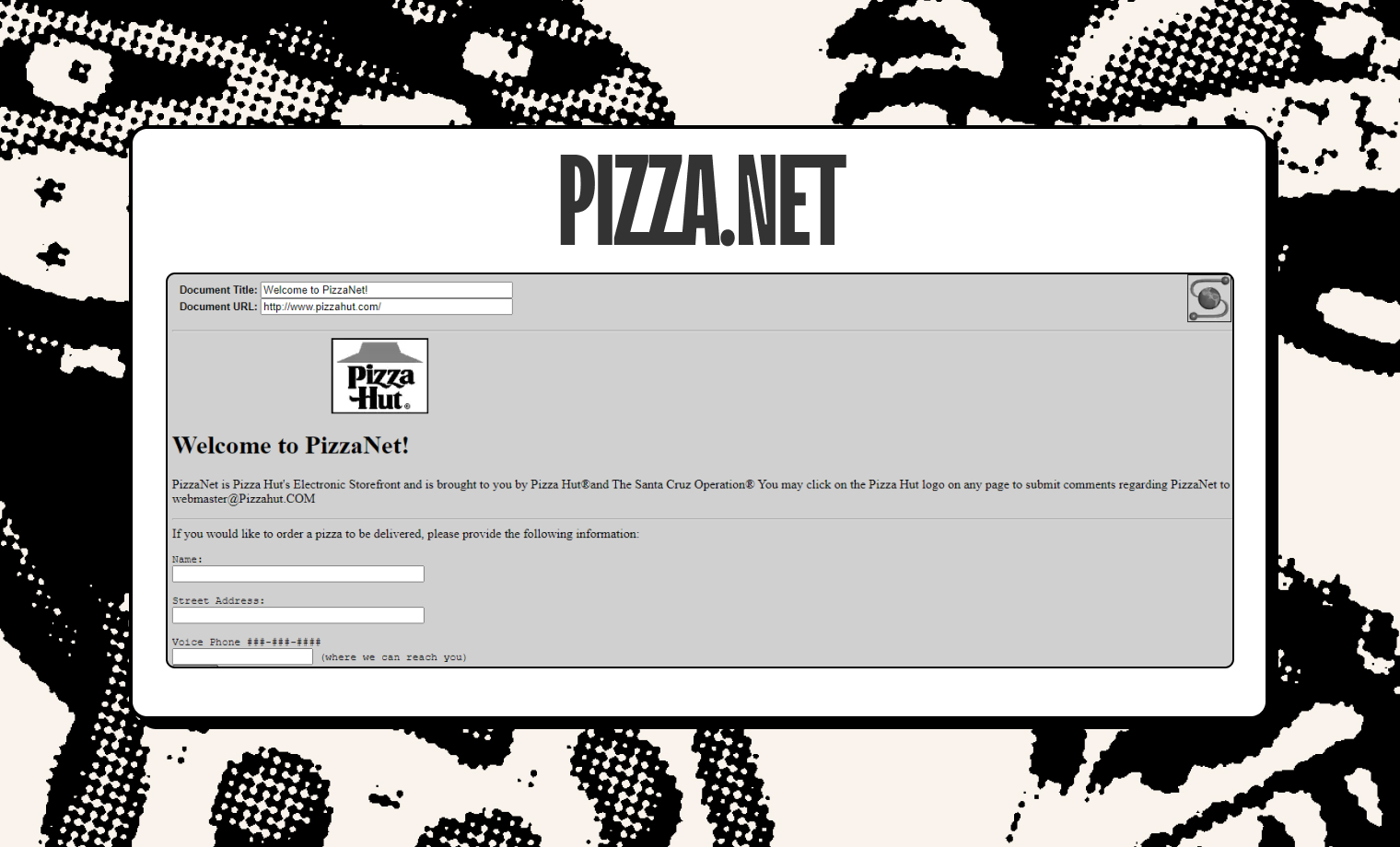
The very first online restaurant ordering system. Source: Pizza Hut’s PizzaNet.
For the busy customer balancing work, family, chores, to-do lists, and life in general, the last thing they want to deal with is complications with their takeout food. Ordering food online should serve the purpose of being quick, convenient, and streamlined.
Before the COVID-19 pandemic, ordering food online from restaurants had been steadily increasing. In fact, in 2019, about 60 percent of foodservice sales came from off-premise ordering.
After the pandemic hit, online restaurant ordering systems and food delivery was a salvation to restaurants that struggled to keep their doors open and sales flowing in. With dining in and going inside storefronts to order no longer an option, online and mobile orders increased by 286 percent during this time.
Now, online ordering is not just a popular trend – it’s a system that is expected and relied on by the customer, as well as an essential tool for the survival of restaurants.
Benefits of Online Restaurant Ordering Systems
Phone-in orders can easily get jumbled (think of all the background noises in a restaurant!) and waiting in line to place an order only makes the hungry customer hangry. Although customers have been trickling back to dining in restaurants, many still prefer a contactless experience when possible. Online ordering through a restaurant ordering system has become the standard for many restaurants, especially after the start of the pandemic.
What makes online ordering so great? We can think of at least 10 reasons why:
1. Ease of ordering.
An online menu ordering system allows restaurants to display an up-to-date menu, and remove out-of-stock items as they sell out. Therefore, the customer is always viewing a real-time menu. Instead of a customer asking specific questions about allergens on the phone, all of this info can be listed on the ordering dashboard for each menu item. With a few taps of a finger, every menu item the customer desires is in their cart.
Modifications desired? Easy, the customer can add notes to their order and select modifications with a simple click. The payment process can then be securely completed on a computer or phone screen. From viewing the menu to paying, every part of the ordering process is streamlined through the online menu ordering system.
2. Efficient customer and order management.
Using an online system means saying goodbye to physical paper orders. These order slips are subject to getting lost in the hustle and bustle of the kitchen. Instead of the back-of-house staff trying to determine which order came first, everything is displayed in the order in which they were placed and consolidated into a single dashboard. This makes life easier for both restaurant management and staff.
3. Monitor your expenses incurred in real-time.
Having access to real-time data allows restaurants to make informed business decisions (we're looking at you restaurant owners). As orders roll in and are being prepared, you can monitor costs incurred. Online ordering systems track sales and the profitability of different menu items. Without ever opening a cash register or counting money, you can have access to real-time data anytime and anywhere.
4. Exposure.
An online presence as a restaurant gets you in front of future customers. All site visitors are potential customers, and you want to ensure that once someone is on your site, the ordering process is straightforward and appealing. Some companies that offer online ordering systems also assist with shaping digital presence, which is important for communicating a restaurant’s brand and personality. Advertisements and billboards are pricey, and simply gaining exposure through having a digital presence costs a fraction of the price.
5. Better customer data.
The more customer data a restaurant has, the better a restaurant is equipped to stay competitive and on top of ordering trends. Customer data allows restaurants to see who their regulars are, what specials and menu items do well, and how customers prefer to order. Once armed with this information, restaurants can offer a personalized experience to customers and execute appropriate marketing campaigns.
Gathering data over a few days, weeks, months, or even years better prepares restaurants for the future. For example, say last October your restaurant sold out of butternut squash soup every day during the lunch rush. This data informs you that you should probably be prepared with a surplus of ingredients for butternut squash soup during this October to ensure that your restaurant is maximizing profits from this menu item.
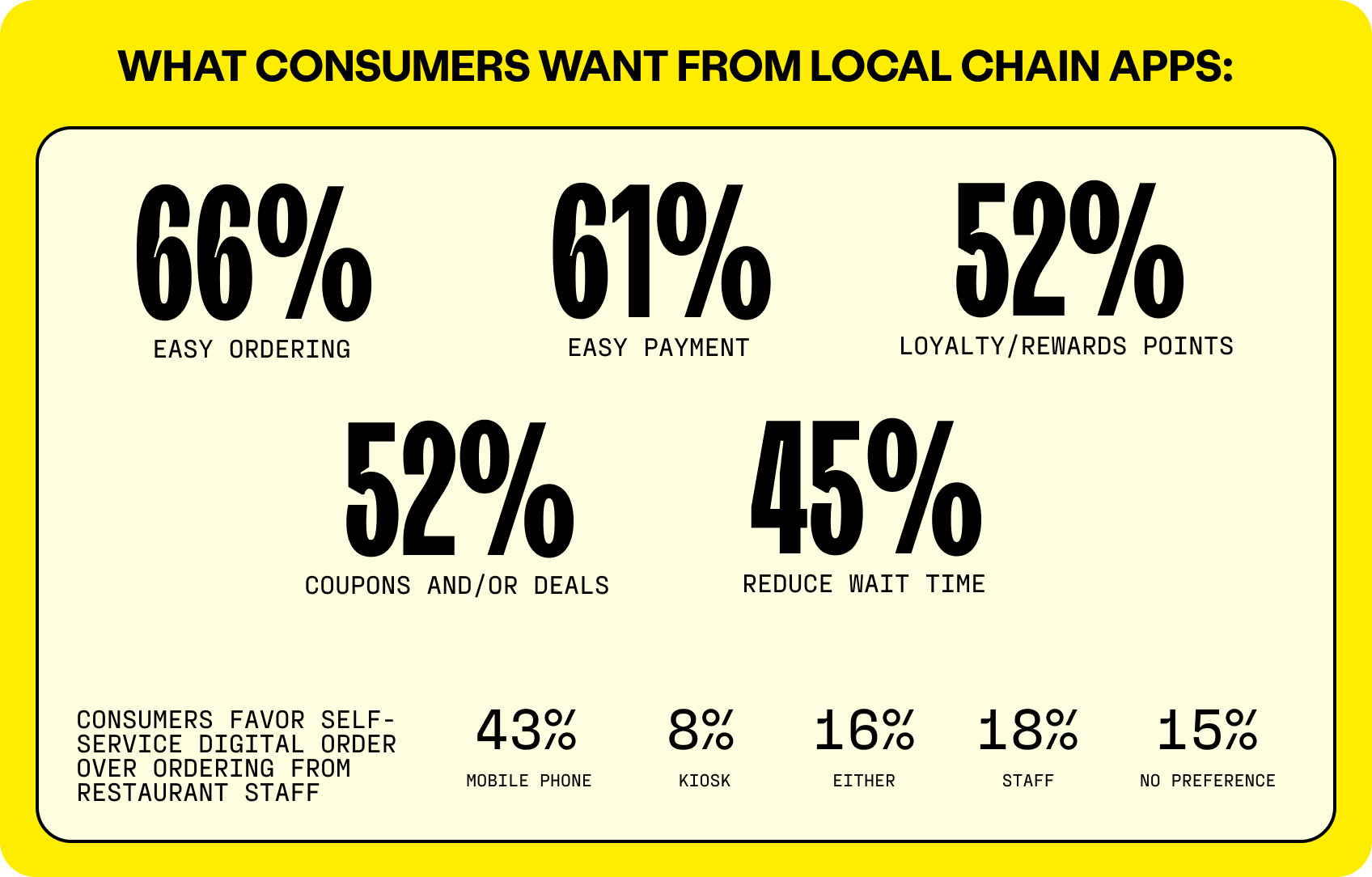
Customers have the strongest preference for mobile ordering. Source: Bluedot’s “The State of What Feeds Us” report
6. The convenience of mobile ordering.
Customers have increasingly continued to turn to mobile ordering due to its convenience. Ordering everything from clothing to groceries online has become the norm, so it’s no surprise that 84 percent of surveyed consumers order food for delivery or takeout once or twice a week. With mobile ordering, a customer can order food from wherever and whenever.
Even if customers chose to dine-in at a restaurant, ordering from their mobile phones can ensure contactless service if this is desired. If at any point a customer wants another drink or menu item, they can simply order via their mobile phone, rather than trying to flag down the staff. This method bodes well for rushes or when a restaurant is short-staffed.
7. Stay ahead of the competition.
All large restaurant chains have online ordering systems and delivery services, and many single-unit restaurants have also adopted these systems, especially after the pandemic-caused shutdowns. At this point, customers now have the expectation that they should be able to order takeout from your restaurant online via a webpage or mobile app. If your restaurant doesn’t offer this, then you run the risk of losing a customer to another that does.
8. Greater reach.
Every restaurant has a seating capacity, but online ordering maximizes the number of customers that eat at your restaurant. This can be done without expanding the size of your restaurant, but simply through having an online ordering system.
Additionally, even when a restaurant is not open, customers can place and schedule orders ahead of time. This allows restaurants to make a profit outside of operating hours.
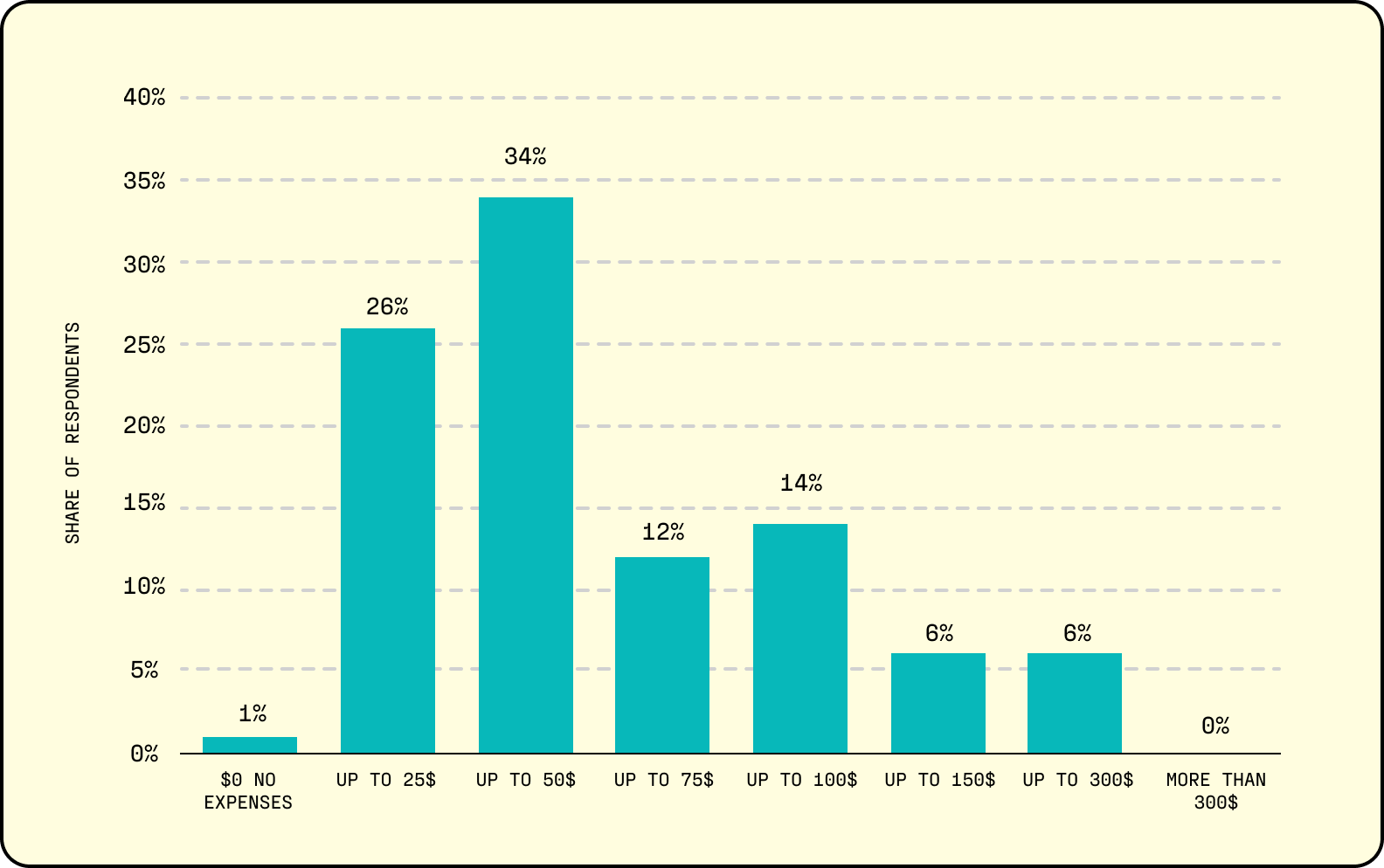
How much customers report spending on online orders. Source: Statista
9. Maximize profits.
Research has found that when customers order online, their orders are typically larger and more expensive. Twenty percent of consumers said they spend more on online orders, and 34 percent spend at least $50 on online takeout orders. When ordering via a phone app or website, customers can take their time looking through menu items, view photos of each, read descriptions, and view the price. It’s much easier to be impulsive with add-ons when ordering only with the click of a button.
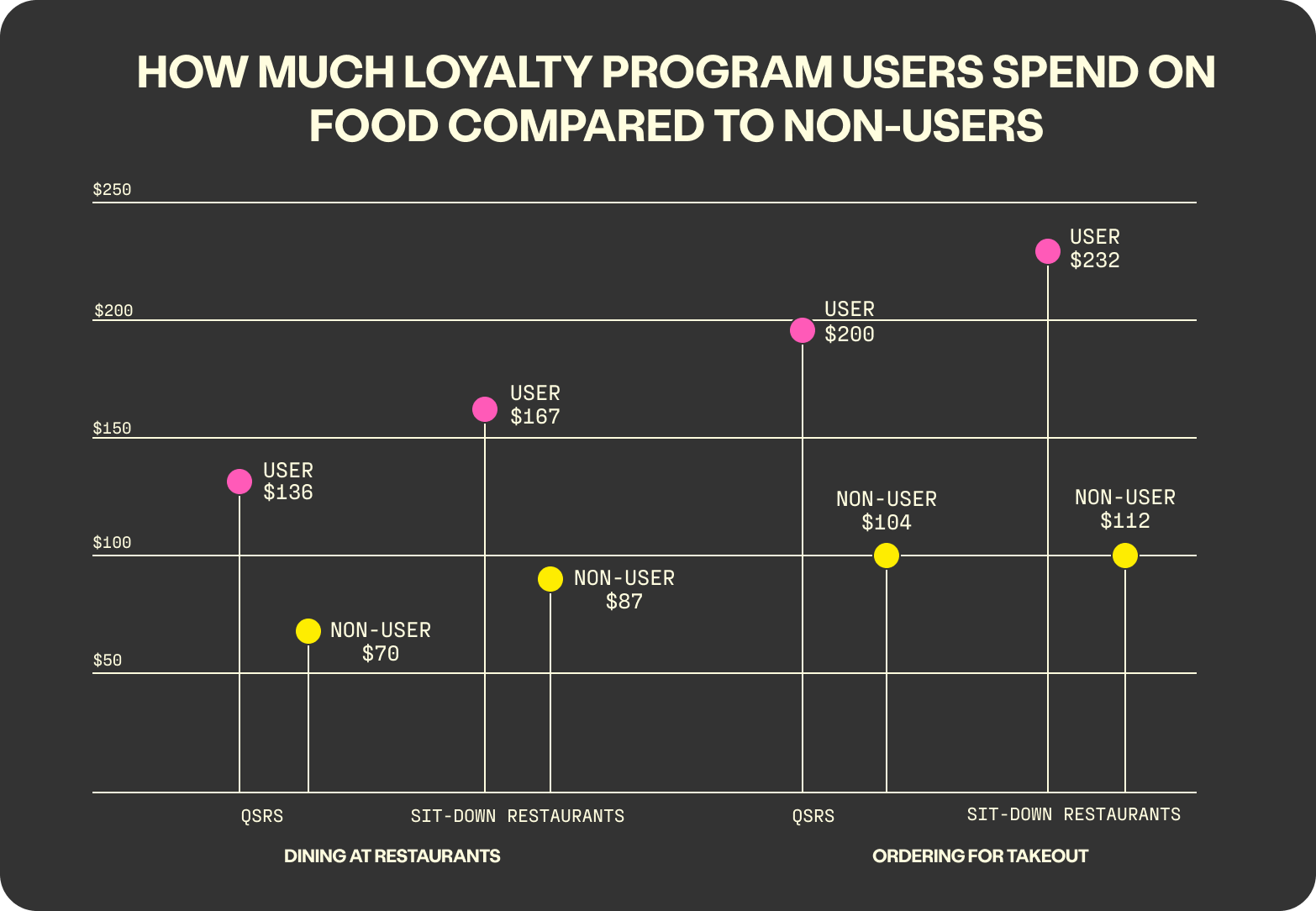
Diners apart of loyalty programs become repeat customers who spend more. Source: Paytronix’s “Delivering On Restaurant Rewards”, January 2021
10. Loyalty programs.
In 2020, at the height of the pandemic, loyalty programs offered restaurants a way to connect with their customers and keep them coming back. Customers who belong to a loyalty program were found to spend twice as much compared to those who were not. Starbucks has one of the most robust loyalty programs, boasting over 16 million members (as of 2019). The company credits it with creating 40 percent of all store sales.
Third-Party Delivery Apps vs Online Food Ordering Systems
According to Forbes, GrubHub’s biggest asset is data. The company gathers data from customers that place over 150,000 a day with the platform. Unfortunately, platforms like GrubHub do not share this valuable data with the restaurants. When restaurants use third-party online ordering systems, like GrubHub, UberEats, or Doordash, they are missing out on the data of hundreds upon thousands of customers.
When restaurants use third-party platforms to complete online orders, they lose the ability to update their menus in real-time. If a menu item sells out, this typically cannot be updated immediately, which can lead to frustrated customers.
Third-party delivery platforms are notorious for taking money out of restaurants’ pockets with their high commission fees. Customers understand this too – 70 percent of surveyed customers reported that they prefer to order directly from restaurants, rather than from third-party platforms. Customers want to support restaurants, and having an online ordering system makes it easy to do this.
How to Choose an Online Restaurant Ordering System
With so many online ordering systems vying for your attention, there are certain components to consider before deciding on one. In your search be sure to analyze the system’s ability to be customized, ease of integration, fees and costs, promotional support, and access to customer data.
1. Ability to customize.
Every restaurant has its own personality and voice, and this should be presented in its online presence. Third-party platforms take away a restaurant’s ability to own its brand, but an online ordering system should allow a restaurant to customize its design and templates.
In addition to online and mobile ordering capabilities, many companies offer extra tools and features. Functionality is key and restaurants should be able to select and pay for only explicitly what they need.
2. Ease of integration.
Managing incoming orders from various channels is a challenge, but integrating an online ordering system should not be. The best online ordering platforms are intuitive to install and easy to learn and understand by both staff and managers. If a hiccup arises, then customer service should be available to assist. Ideally, the system you choose should be able to integrate into your existing systems.
3. Fees and costs.
Each restaurant will have different needs, as well as different budgets. Luckily, most online ordering systems are offered at different pricing tiers. The online ordering system you choose will ideally allow you to start small, and scale up as you go. Most companies offer free consultations, and some even offer $0 monthly fees for their most basic offering. Some systems may require you to pay for their hardware in addition to the software. Be aware of companies that charge a commission per order.
4. Promotional support.
Some companies offer promotional marketing and support along with their online ordering systems. This is typically offered at an additional cost, but some companies bundle this with the operational costs of the online ordering system. Promotional support might include assistance with building your restaurant website including an online menu, creating a custom web page, search engine optimization, social media, driving website traffic, and more.
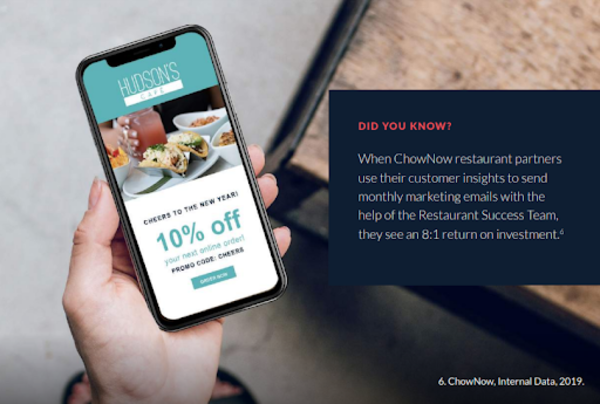
Customer data can be used to run successful marketing campaigns. Source: ChowNow’s “The 6 Ways Online Ordering Will Transform Your Restaurant’s Efficiency”
5. Access to customer data.
As stated, data is a major asset. The more you know about your customers, the better prepared your restaurant is to offer a personalized experience. With so many restaurants to choose from, a customer will likely choose to dine where they feel catered to and leave feeling satisfied. (Refer to “Better customer data” above”.)
12 Best Online Food Ordering Systems For Restaurants
It is important to analyze the pros and cons of each system before choosing which would serve your restaurant best. In addition to web ordering and mobile ordering apps, some systems may offer additional features and tools to help manage your restaurant’s operations and grow its digital presence.
1. Lunchbox.
Lunchbox is an operating system that focuses on maximizing restaurant guests, orders, and profit. To create a customizable digital ordering experience, it offers features such as app ordering, web ordering, and kiosks. Lunchbox works with restaurants of all sizes to help them take back their digital real estate from third-party ordering platforms.
2. Toast POS.
Toast POS offers tools like online ordering, delivery, takeout, mobile app ordering, e-gift card purchasing, and contactless payment. Made for exclusively the foodservice industry, the cloud-based platform allows users to access restaurant data from anywhere, including on mobile devices. Toast Go (handheld tablets) can be used for tableside ordering and payment processing, and Toast Kiosks are an option for customer self-service.
3. Square POS.
Square Point of Sale system is free to use, and assists all types of businesses, including restaurants, with selling online. The company’s system enables customer preferences to be tracked, feedback recorded, and inventory reports to be created. Real-time data is recorded with sales reports available every hour. Customer information can be used to build profiles and create targeted marketing campaigns.
4. ChowNow.
ChowNow allows for customers to order for in-store pick up, curbside delivery, and contactless dine-in. Order can be placed via a restaurant’s app, website, or platforms like Google or Instagram. The company has a Success Team to help restaurants grow their to-go businesses, using marketing and social media tactics. This system is commission-free.
5. MenuDrive.
MenuDrive offers online and mobile marketing solutions for restaurants and caterers. It uses marketing tools and Search Engine Optimization to drive traffic to restaurant sites, converting visitors to new customers. With its analytics, MenuDrive shares what menu items should be promoted and what the best selling prices are to achieve ideal profit margins.
6. Upserve.
Upserve is designed by restaurateurs for restaurateurs. The cloud-based POS system can be installed and running within 48 hours. The company builds online menus and personalized web pages for restaurants to highlight the brand and streamline the online ordering process.
7. Restolabs.
Restolabs allows restaurants to create a customized ordering site that encompasses their personality and voice. Key features include POS integration, an intuitive interface, Facebook ordering, and multilingual customer support.
8. CAKE POS.
CAKE offers its intuitive POS system to both quick and full-service restaurants. Quick service restaurants can take advantage of Orderpads that control diner traffic flow and offer a customer-facing display for diners to pay and sign. For larger, full-service restaurants, the POS system can provide table status updates and guest profiles. Other features of this system include tracking real-time sales, sales reports, and employee hours and wages.
9. iMenu360.
iMenu360’s online ordering system can integrate into a restaurant’s existing POS system and accept online website orders and mobile orders. Key features of this system include customer data collection, 24/7 customer service, individually branded apps, and the ability to create a loyalty program. This system is also used by the U.S. Military.
10. GloriaFood.
According to GloriaFood, it’s the first fully free online ordering system. Its system offers unlimited order processing at no cost. In addition to online ordering, the company offers online branding and online table reservations. The company works with over 20,000 restaurants throughout 100 countries, and supports 37 different languages.
11. Ordering.co.
In addition to being an online ordering system, Ordering.co also offers a POS interface, WhatsApp ordering integration, real-time order tracking, and AI order assignment. Ordering.co is an all-in-one solution for any on-demand delivery business, and order kiosks. According to the company, all types of businesses are supported, and its system can be set up in less than a day.
12. eDelivery.
eDelivery’s online ordering system can be used by restaurants, foodservice operators, grocery stores, and liquor stores that offer local delivery. For customization, different screen designs and templates are offered free of charge, with custom designs offered for a small fee.
Why Online Ordering For Restaurants Is So Important
There are plenty of reasons to integrate an online ordering system into your restaurant, including convenience, larger takeout orders, better customer data, and order management. In 2021 alone, it’s predicted that 821 million customers will order food online. In reality, a customer might not choose to eat at your restaurant if you don’t have a streamlined ordering system. Equipped with the right system, your restaurant can maintain a competitive edge that keeps customers coming back for more.